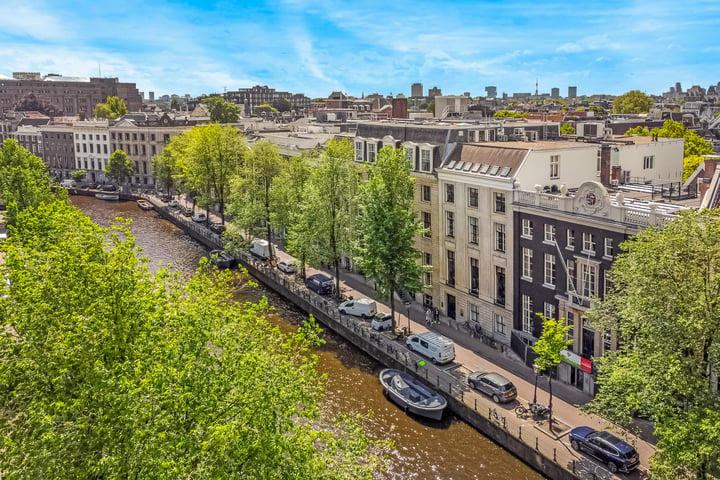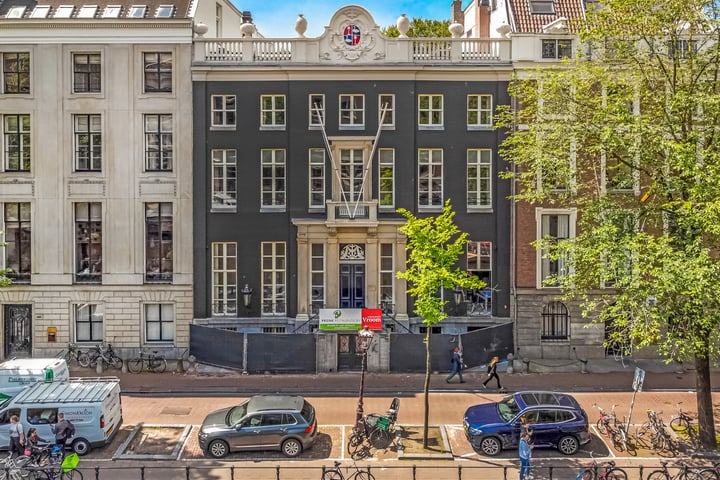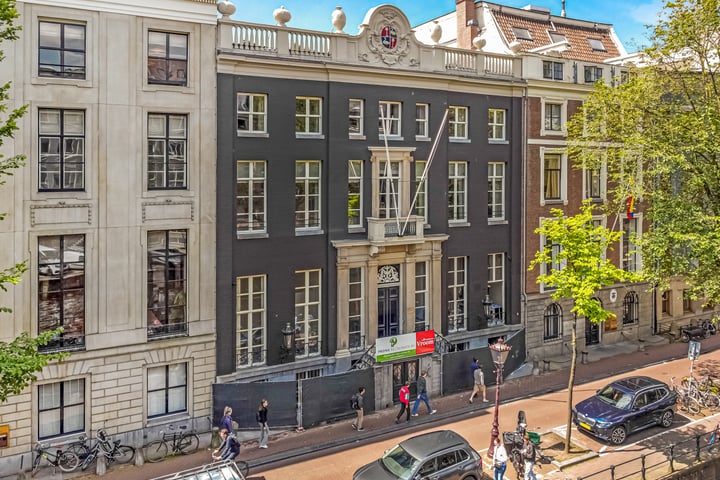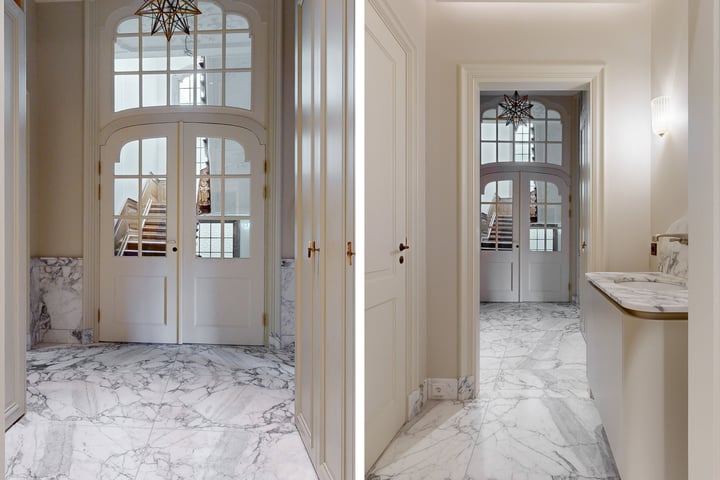Description
Herengracht 446 A
You are looking for a 292 m2 flat on the 1st floor with lift and parking in a particularly large monumental canal house on the Golden Bend of Amsterdam
The canal house measures a total of 1335 m2 GFA and has a width of 16.50 and a depth of 16.50, allowing for a unique floor plan with a special layout.
It seems like a hopeless task, but this is your chance; a completely new flat (2024) with lift in a true city palace full of history on the most beautiful spot in Amsterdam that includes a parking space for the car.
It seems like a catch 22. You want the rich history of a monumental canal house, but also the freedom to live a 21st-century life in it. This property on the Golden Bend of the Herengracht offers you a unique opportunity: impressive period rooms restored to the highest level, wall coverings, kitchen and sanitary fittings are unique, the sustainable installations provide cooling and heating.
You can live and work in the building if you wish.
If you choose this location, you will follow in the footsteps of the first occupant, Andries de Graeff (1611 - 1678). The name may not mean anything to you, but in the seventeenth century, Mr De Graeff was mayor of Amsterdam seven times and received his many high-ranking guests here. Andries was the prototype of Amsterdam's Golden Age regent: libertine, art lover (Rembrandt painted his portrait), supporter of the republic and yet, conditionally and when it suited, Orangist.
A typical Dutch pragmatist, then, but also a bit of a snob. For instance, he had research done to find out whether the ‘bourgeois’ De Graeffjes might not somehow be of nobility after all. Naturally, the genealogists - whose bread you eat, whose word you speak - found a vague line to the Tyrolean noble Von Graben von Stein family. Incidentally, De Graeff already had plenty of famous relatives: Pieter Corneliszoon Hooft was his uncle, Frans Banninck Cocq - yes, the one from the Night Watch - was his brother-in-law, and Johan and Cornelis de Witt were his cousins, with whom he worked closely in stirring national politics. Andries's influence and purse stretched far - he was among the 250 richest in 1674 - and the place where he had his house built was a good fit. The location of your house was of great importance even in the seventeenth century. So in 1669, the ground was broken on the best - and most expensive - spot in Amsterdam for the three-year construction of a double house that, at 16.25 metres, is one of the widest houses on Amsterdam's canals. Seven axes of windows make up the facade, which is literally unique. A sign of great wealth, since at the time so-called ‘gable tax’ was levied on canal houses - the wider the gable, the higher the assessment. That facade itself, by the way, is now eighteenth-century; only the Doric door frame remains from Andries' time. That eighteenth-century conversion is also largely responsible for the phenomenal interior of the remaining period rooms. Think beautiful stucco reliefs and red marble fireplaces, among other things. During the eighteenth-century renovation, they did keep their hands off the three ceiling paintings that Andries had ordered from the famous classicist painter Gerard de Lairesse. For centuries they adorned the building, until in 1903 the then owner sold them for 8,300 guilders to the newly built Peace Palace. Now at the restoration in 2024, the ceiling paintings have returned to the monument.
After all, the subject of the paintings, interpreted as ‘Triumph of Peace’, seemed right at home there. That they were actually about the freedom of trade, buyer and seller apparently did not know. Unfortunately, there is no chance of recovering the paintings. This did succeed with the 1672 ceiling in the right front room: sixteen coats of arms of Andries, his wife Elisabeth Bicker van Swieten, et cetera, in wood. Discovered in 1911, sold in 1917, bought back in 1959. That several owners monetised parts of the interior may have had to do with their ‘core business’: the building housed several banks. The vault in the basement still witnessed this; it has now been removed in 2024 for a new function.
Now it's up to you to write the next chapter in the history of one of Amsterdam's most famous canal houses.
Description Rijksdienst voor de Monumenten:
Double house (XVII B) with gable under straight moulding and attic, with sandstone front facade to which balconies XVII B,
remodelled XVIIIa/b (attic centre etc.) and + 1800 (window surround, attic vases, pavement, stoop posts and gate,
window railings, carved window, rose panelling and 2 gable lanterns). Interior: very fine stucco decoration in front house,
hallway and staircase, as well as banister XVIIIa/b; interior of left back room, buffet niches of right front room and
right front room and stucco ceiling of garden room Louis XV.
Rent
The rent originally amounted to EUR 24,000 per month. The discount is EUR 6,000 per month for the first three years. As a result, the monthly rent for the first three years amounts to EUR 18,000.
Details
- Living area measured according to NEN 292 m2
- Communal roof terrace
- 4 bedrooms, 2 bathrooms
- Air conditioning with heating and cooling available in all rooms
- WTW unit; a heat recovery unit keeps air flows in balance.
- Solid oak flooring throughout the flat
- Underfloor heating available throughout the flat
- Use of high-quality materials
- Flos lighting throughout the flat
- Bulthaup kitchen with Quooker
- Italian design baths and sinks
- The flat has an energy label A+
- The building in which the apartment is located was fully insulated during construction
- Parking within walking distance
- The apartment has an alarm system
Features
Transfer of ownership
- Rental price
- € 18,000 per month (no service charges)
- Deposit
- € 54,000 one-off
- Rental agreement
- Indefinite duration
- Listed since
- Status
- Available
- Acceptance
- Available immediately
Construction
- Type apartment
- Upstairs apartment
- Building type
- Resale property
- Year of construction
- 1670
- Accessibility
- Accessible for the elderly
- Specific
- Protected townscape or village view (permit needed for alterations), double occupancy possible, with carpets and curtains and listed building (national monument)
Surface areas and volume
- Areas
- Living area
- 292 m²
- Exterior space attached to the building
- 2 m²
- Volume in cubic meters
- 1,143 m³
Layout
- Number of rooms
- 6 rooms (3 bedrooms)
- Number of stories
- 2 stories
- Located at
- 1st floor
- Facilities
- Air conditioning, alarm installation, balanced ventilation system, elevator, mechanical ventilation, TV via cable, and solar panels
Energy
- Energy label
- Heating
- CH boiler
- Hot water
- CH boiler
Exterior space
- Garden
- Sun terrace
- Sun terrace
- 12 m² (4.00 metre deep and 3.00 metre wide)
- Garden location
- Located at the southwest
Garage
- Type of garage
- Parking place
Want to be informed about changes immediately?
Save this house as a favourite and receive an email if the price or status changes.
Popularity
0x
Viewed
0x
Saved
06/11/2024
On funda




